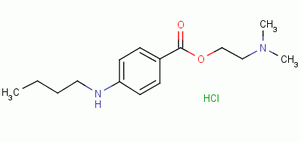Home > Offer to Sell > Pharmaceuticals and Biochemicals > Immunomodulator > Local Anesthetic CAS 136-47-0 Tetracaine Hydrochloride (Tetracaine HCl)
Local Anesthetic CAS 136-47-0 Tetracaine Hydrochloride (Tetracaine HCl)
Inquiry
| Post Date: | Nov 20,2017 |
| Expiry Date: | Nov 20,2018 |
| Detailed Description: |
Cas No. :136-47-0
Quantity: 1000Kilograms Specs:foil bag Price:1 USD Kilograms Payment Method: Western Union, money gram, t/t, bitcoin Local Anesthetic CAS 136-47-0 Tetracaine Hydrochloride (Tetracaine HCl) What is Tetracaine Hydrochloride ? Tetracaine HCl is synthesized from 4-butylaminobenzoic acid. The ethyl ester is formed through an acid-catalyzed esterification reaction. Base-catalyzed transesterification is achieved by boiling the ethyl ester of 4-butylaminobenzoic acid with excess 2-dimethylaminoethanol in the presence of a small amount of sodium ethoxide. Tetracaine is the T in Tac, a mixture of 5 to 12 per cent tetracaine, 5‱ (per myriad), a half per mille (0.5‰), or .05 per cent (1 part in 2000) adrenaline, and 4 or 10 per cent cocaine hydrochloride used in ear, nose & throat surgery and in the emergemcy department where numbing of the surface is needed rapidly, especially when children have been injured in the eye, ear, or other sensitive locations. It is on the World Health Organization's List of Essential Medicines, a list of the most important medication needed in a basic health system. A systematic review and meta-analysis of randomised controlled trials investigated tetracaine for use in emergency departments, especially for IV cannulation in children, in view of its analgesic and cost-saving properties - however it did not find a statistically significant improvement in first attempt cannulations. Quick Detail: Product name Tetracaine hydrochloride Other name L and ocain hydrochloride; Intercain hydrochloride; Meethobalm hydrochloride; CAS 136-47-0 MF C15h25cln2o2 MW; 300.82 Molecular structure Assay 99% Appearance: White crystalline powder Usage local anaesthetic Description: 1.In biomedical research, tetracaine is used to alter the function of calcium release channels (ryanodine receptors) that control the release of calcium from intracellular stores. Tetracaine is an allosteric blocker of channel function. At low concentrations, tetracaine causes an initial inhibition of spontaneous calcium release events, while at high concentrations, tetracaine blocks release completely. 2.Tetracaine is the T in Tac, a mixture of 5 to 12 per cent tetracaine, 5M(per myriad), a half per mille (0.5‰), or .05 per cent (1 part in 2000) , and 4 or 10 per cent hydrochloride used in ear, nose & throat surgery and in the emergemcy department where numbing of the surface is needed rapidly, especially when children have been injured in the eye, ear, or other sensitive locations. 3.Tetracaine is synthesized from 4-butylaminobenzoic acid. The ethyl ester is formed through an acid-catalyzed esterification reaction. Base-catalyzed transesterification is achieved by boiling the ethyl ester of 4-butylaminobenzoic acid with excess 2-dimethylaminoethanol in the presence of a small amount of sodium ethoxide. Application: Tetracaine is a potent local anesthetic of the ester group. It is mainly used topically in ophthalmology and as an antipruritic, and it has been used in spinal anesthesia. In biomedical research, tetracaine is used to alter the function of calcium release channels (ryanodine receptors) that control the release of calcium from intracellular stores. Tetracaine is an allosteric blocker of channel function. At low concentrations, tetracaine causes an initial inhibition of spontaneous calcium release events, while at high concentrations, tetracaine blocks release completely. COA Items QUALITY STANDARDS RESULTS Description White or almost white crystalline powder White crystalline powder Solubility Matching with the working standard Complies Identification A.By IR, To match with working standard Complies B: To 10ml of solution S add 1ml of ammonium thiocyanate solution R.A white,crystalline precipitate is formed which,after recrystallisation from water R and drying at 80ºC for 2h,melts at about 131ºC Complies C. To about 5mg add 0.5ml of fuming nitric acid R .Evaporate to dryness on a water-bath,allow to cool and dissolve the residue in 5ml of acetone R.Add 1ml of 0.1M alcoholic potassium hydroxide.A violet colour develops Complies D. Solution S gives reaction of chlorides. Complies PH 4.5~6.5 5.78 Residual Solvents Conform to standard Complies Claruty Solution should be clear Complies Related Substances Conform to standard Complies Heavy metals ≤10ppm <10ppm Loss on drying ≤1.0% 0.87% Resiue on ignition ≤0.1% 0.05% Melting range 148ºC 147.5ºC~150.8ºC Assay(*) 99%~101.0% 100.40% Conclusion The Sample Complies With Specification of EP8 Usage: The efficacy profile of lidocaine as a local anesthetic is characterized by a rapid onset of action and intermediate duration of efficacy. Therefore, lidocaine is suitable for infiltration, block, and surface anesthesia. Longer-acting substances such as bupivacaine are sometimes given preference for subdural and epidural anesthesias; lidocaine,though, has the advantage of a rapid onset of action. In dental anesthesia, a relative insensitivity to lidocaine can occur for anatomical reasons due to unexpected positions of nerves. Some people with Ehlers-Danlos syndrome are insensitive to lidocaine. Related Products: Benzocaine CAS: 94-09-7 Lidocaine CAS: 137-58-6 Propitocaine hydrochloride CAS: 1786-81-8 Tetracaine hydrochloride CAS: 136-47-0 Procaine hydrochloride CAS: 51-05-8 Pramoxine hydrochloride CAS: 637-58-1 Tetracaine CAS: 94-24-6 Proparacaine hydrochloride CAS: 5875-06-9 Procaine CAS: 59-46-1 Benzocaine hydrochloride CAS: 23239-88-5 Lidocaine hydrochloride CAS: 73-78-9 Articaine hydrochloride CAS: 23964-57-0 Levobupivacaine hydrochloride CAS: 27262-48-2 Ropivacaine hydrochloride CAS: 132112-35-7 Dibucaine hydrochloride CAS: 61-12-1 Bupivacaine hydrochloride CAS: 14252-80-3 Articaine CAS: 23964-58-1 |
| CAS Registry Number: | 136-47-0 |
| Synonyms: | ;Tetracaine HCl;2-dimethylaminoethyl 4-n-butylaminobenzoate hydrochloride;4-(Butylamino)benzoic acid 2-(dimethylamino)ethyl ester hydrochloride;4-(butylamino)-Benzoic acid, 2-(dimethylamino)ethyl ester, monohydrochloride;p-butylaminobenzoyl-2-dimethylaminoethanol hydrochloride;Amethocaine hydrochloride;Anethaine;Butethanol;Curtacain;Decicain;Gingicain M;Menonasal;Pantocaine;Pontocaine hydrochloride;Tonexol;Tetracaine·HCL;2-(dimethylamino)ethyl 4-(butylamino)benzoate hydrochloride (1:1);Tertracaine HCL; |
| Molecular Formula: | C15H25ClN2O2 |
| Molecular Weight: | 300.8242 |
| Molecular Structure: | 
|
| Hazard Symbols: |  T:Toxic; T:Toxic; |
| Risk Codes: | R25:; R36:; R43:; |
| Safety Description: | S26:; S36/37:; S45:; |
| Company: | Hengyang Desen Biotechnology Co., Ltd. [ China ] |
| Contact: | Koala |
| Tel: | +86-073-48164621 |
| Fax: | 027-88608190-722 |
| Email: | koala@desen-nutrition.com |
-
Disclaimer statement:The information and data included above have been realized by the enterprises and compiled by the staff, and are subject to change without notice to you. The Chemnet makes no warranties or representations whatsoever regarding the facticity, accuracy and validity of such information and data. In order to ensure your interest, we suggest you chose the products posted by our gold suppliers or VIP members.


